Related Research Articles
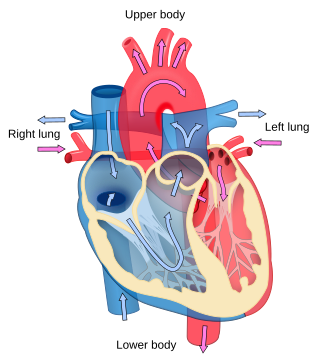
Cardiology is the study of the heart. Cardiology is a branch of medicine that deals with disorders of the heart and the cardiovascular system. The field includes medical diagnosis and treatment of congenital heart defects, coronary artery disease, heart failure, valvular heart disease, and electrophysiology. Physicians who specialize in this field of medicine are called cardiologists, a specialty of internal medicine. Pediatric cardiologists are pediatricians who specialize in cardiology. Physicians who specialize in cardiac surgery are called cardiothoracic surgeons or cardiac surgeons, a specialty of general surgery.

Cardiac arrest, also known as sudden cardiac arrest, is when the heart suddenly and unexpectedly stops beating. As a result blood will not be pumped around the body in normal circulation, consciousness will be rapidly lost, and breathing will be abnormal or absent. Without immediate intervention such as cardiopulmonary resuscitation (CPR), and possibly defibrillation, death will occur within minutes.

Cardioversion is a medical procedure by which an abnormally fast heart rate (tachycardia) or other cardiac arrhythmia is converted to a normal rhythm using electricity or drugs. Synchronized electrical cardioversion uses a therapeutic dose of electric current to the heart at a specific moment in the cardiac cycle, restoring the activity of the electrical conduction system of the heart. Pharmacologic cardioversion, also called chemical cardioversion, uses antiarrhythmia medication instead of an electrical shock.

Ventricular fibrillation is an abnormal heart rhythm in which the ventricles of the heart quiver. It is due to disorganized electrical activity. Ventricular fibrillation results in cardiac arrest with loss of consciousness and no pulse. This is followed by sudden cardiac death in the absence of treatment. Ventricular fibrillation is initially found in about 10% of people with cardiac arrest.

A ventricle is one of two large chambers toward the bottom of the heart that collect and expel blood towards the peripheral beds within the body and lungs. The blood pumped by a ventricle is supplied by an atrium, an adjacent chamber in the upper heart that is smaller than a ventricle. Interventricular means between the ventricles, while intraventricular means within one ventricle.
Fibrillation is the rapid, irregular, and unsynchronized contraction of muscle fibers. An important occurrence is with regard to the heart.
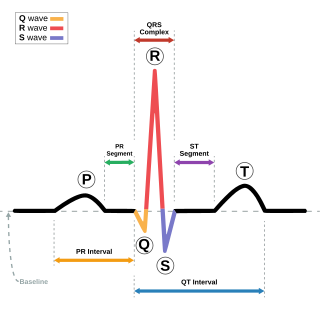
Short QT syndrome (SQT) is a very rare genetic disease of the electrical system of the heart, and is associated with an increased risk of abnormal heart rhythms and sudden cardiac death. The syndrome gets its name from a characteristic feature seen on an electrocardiogram (ECG) – a shortening of the QT interval. It is caused by mutations in genes encoding ion channels that shorten the cardiac action potential, and appears to be inherited in an autosomal dominant pattern. The condition is diagnosed using a 12-lead ECG. Short QT syndrome can be treated using an implantable cardioverter-defibrillator or medications including quinidine. Short QT syndrome was first described in 2000, and the first genetic mutation associated with the condition was identified in 2004.
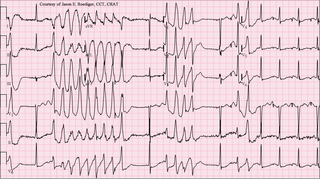
Torsades de pointes, torsade de pointes or torsades des pointes is a specific type of abnormal heart rhythm that can lead to sudden cardiac death. It is a polymorphic ventricular tachycardia that exhibits distinct characteristics on the electrocardiogram (ECG). It was described by French physician François Dessertenne in 1966. Prolongation of the QT interval can increase a person's risk of developing this abnormal heart rhythm, occurring in between 1% and 10% of patients who receive QT-prolonging antiarrhythmic drugs.
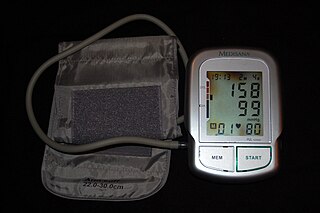
Hypertensive heart disease includes a number of complications of high blood pressure that affect the heart. While there are several definitions of hypertensive heart disease in the medical literature, the term is most widely used in the context of the International Classification of Diseases (ICD) coding categories. The definition includes heart failure and other cardiac complications of hypertension when a causal relationship between the heart disease and hypertension is stated or implied on the death certificate. In 2013 hypertensive heart disease resulted in 1.07 million deaths as compared with 630,000 deaths in 1990.

Commotio cordis is a rare disruption of heart rhythm that occurs as a result of a blow to the area directly over the heart at a critical instant during the cycle of a heartbeat. The condition is 97% fatal if not treated within three minutes. This sudden rise in intracavitary pressure leads to disruption of normal heart electrical activity, followed instantly by ventricular fibrillation, complete disorganization of the heart's pumping function, and cardiac arrest. It is not caused by mechanical damage to the heart muscle or surrounding organs and is not the result of heart disease.
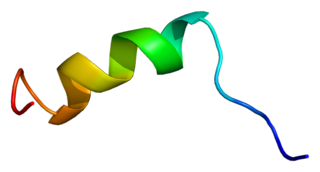
Sodium channel protein type 5 subunit alpha, also known as NaV1.5 is an integral membrane protein and tetrodotoxin-resistant voltage-gated sodium channel subunit. NaV1.5 is found primarily in cardiac muscle, where it mediates the fast influx of Na+-ions (INa) across the cell membrane, resulting in the fast depolarization phase of the cardiac action potential. As such, it plays a major role in impulse propagation through the heart. A vast number of cardiac diseases is associated with mutations in NaV1.5 (see paragraph genetics). SCN5A is the gene that encodes the cardiac sodium channel NaV1.5.
Arthur Martin Vineberg, was a Canadian cardiac surgeon, university lecturer and author. He was famous for his experimental and clinical studies in revascularization of the heart.

Pilsicainide (INN) is an antiarrhythmic agent. It is marketed in Japan as サンリズム (Sunrythm). It was developed by Suntory Holdings Limited and first released in 1991. The JAN applies to the hydrochloride salt, pilsicainide hydrochloride.

Michel Haïssaguerre is a French cardiologist and electrophysiologist. His investigations have been the basis for development of new markers and therapies for atrial and ventricular fibrillation.

The cardiac transient outward potassium current (referred to as Ito1 or Ito ) is one of the ion currents across the cell membrane of heart muscle cells. It is the main contributing current during the repolarizing phase 1 of the cardiac action potential. It is a result of the movement of positively charged potassium (K+) ions from the intracellular to the extracellular space. Ito1 is complemented with Ito2 resulting from Cl− ions to form the transient outward current Ito.
Frank I. Marcus was an American cardiologist and Emeritus Professor of Medicine at the University of Arizona Health Sciences Center, the author of more than 290 publications in peer-reviewed medical journals and of 90 book chapters. He was considered a world expert on arrhythmogenic right ventricular cardiomyopathy (ARVC) and was a member of the Editorial/Scientific Board of 14 Cardiovascular Journals as well as a reviewer for 26 other medical publications.
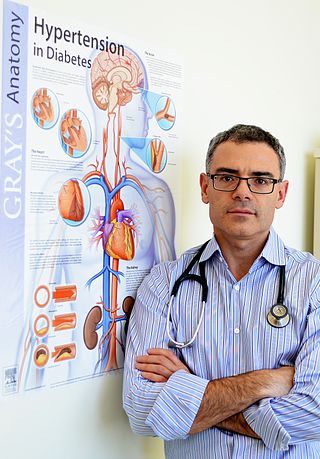
Yaariv Khaykin is a Canadian cardiologist and a clinical researcher in the area of electrophysiology. He is the director of the Newmarket Electrophysiology Research Group at the Southlake Regional Health Centre. He has published research into complex ablation and pioneered cardiac ablation methods.

John Alexander MacWilliam, a physiologist at the University of Aberdeen in the late nineteenth and early twentieth centuries, was a pioneer in the field of cardiac electrophysiology. He spent many years studying ventricular fibrillation, and was the first person to propose that ventricular fibrillation was the most common cause of sudden death - and that fibrillation could be terminated by a series of induction shocks to the heart. He was the first to accurately describe the condition of arrhythmia, and he suggested transthoracic pacing to treat transient asystole . Although his work was recognised within his lifetime, it was not until many decades later that it laid the foundations for developments in the understanding and treatment of life-threatening heart conditions, such as in the artificial cardiac pacemaker. MacWilliam was appointed Regius Professor of the Institutes of Medicine at the University of Aberdeen at the age of 29 in 1886, and remained in that post for 41 years until his retirement in 1927.
George Edward Billman is an American physiologist and professor at Ohio State University. After receiving a Ph.D from the University of Kentucky in 1980, Billman began his professional career at the University of Oklahoma. In 1984, he joined the Ohio State staff, where he became an associate professor in 1990 and a full professor in 1996.
Sanjiv M. Narayan is a British-born American physician, biomedical engineer, and academic researcher. He is a Professor of Medicine at Stanford University. Narayan's work is focused on treating patients with heart rhythm disorders, particularly those with atrial fibrillation. His research applies bioengineering and computational methods to develop improved diagnostic tools and therapy.
References
- 1 2 3 DeSilva RA (1997). "George Ralph Mines, Ventricular Fibrillation and the Discovery of the Vulnerable Period". Journal of the American College of Cardiology . 29 (6): 1397–1402. doi: 10.1016/s0735-1097(97)00067-3 . PMID 9137241.
- ↑ Mines GR (1913). "On dynamic equilibrium in the heart". Journal of Physiology . 46 (4–5): 349–383. doi:10.1113/jphysiol.1913.sp001596. PMC 1420430 . PMID 16993210.
- ↑ Mines GR (1914). "On circulating excitations in heart muscle and their possible relation to tachycardia and fibrillation". Transactions of the Royal Society of Canada. 8: 43–52.
- ↑ Aciernom LJ, Worrell LT (2001). "George Ralph Mines: Victim of Self-Experimentation?". Clinical Cardiology . 24 (8): 571–572. doi:10.1002/clc.4960240810. PMC 6654889 . PMID 11501611.
- ↑ "Frank Campbell MacIntosh Fonds". McGill Archival Collections Catalogue.